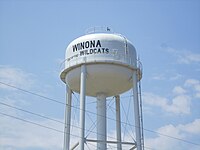Winona, Texas
Winona, Texas | |
|---|---|
 Winona water tower | |
| Motto: "Working for Your Future" | |
 Location of Winona, Texas | |
 | |
| Country | United States |
| State | Texas |
| County | Smith |
| Area | |
| • Total | 1.6 sq mi (4.1 km2) |
| • Land | 1.6 sq mi (4.0 km2) |
| • Water | 0.0 sq mi (0.0 km2) |
| Elevation | 331 ft (101 m) |
| Population (2010) | |
| • Total | 576 |
| • Density | 372.8/sq mi (143.9/km2) |
| Time zone | UTC-6 (Central (CST)) |
| • Summer (DST) | UTC-5 (CDT) |
| ZIP code | 75792 |
| Area code | 903 |
| FIPS code | 48-79828[1] |
| GNIS feature ID | 1350427[2] |
| Website | City of Winona, Texas |




Winona is a town in Smith County, Texas, United States. The population was 576 at the 2010 census. It is part of the Tyler, Texas Metropolitan Statistical Area.
History
Delaware Indians lived in the area as early as 1818. The town was founded in 1870.[3]
Geography
Winona is located at 32°29′27″N 95°10′16″W / 32.490836°N 95.171100°W (32.490836, -95.171100).[4]
According to the United States Census Bureau, the town has a total area of 1.6 square miles (4.0 km2), all land.
Demographics
| Census | Pop. | Note | %± |
|---|---|---|---|
| 1970 | 155 | — | |
| 1980 | 443 | 185.8% | |
| 1990 | 457 | 3.2% | |
| 2000 | 582 | 27.4% | |
| 2010 | 576 | −1.0% | |
| 2015 (est.) | 598 | [5] | 3.8% |
As of the census[1] of 2000, there were 582 people, 217 households, and 157 families residing in the town. The population density was 372.8 people per square mile (144.0/km2). There were 237 housing units at an average density of 151.8 per square mile (58.7/km2). The racial makeup of the town was 86.77% White, 11.00% African American, 0.17% Asian, 0.34% from other races, and 1.72% from two or more races. Hispanic or Latino of any race were 3.09% of the population.
There were 217 households out of which 39.2% had children under the age of 18 living with them, 53.9% were married couples living together, 15.2% had a female householder with no husband present, and 27.2% were non-families. 25.3% of all households were made up of individuals and 16.1% had someone living alone who was 65 years of age or older. The average household size was 2.68 and the average family size was 3.21.
In the town the population was spread out with 29.7% under the age of 18, 7.2% from 18 to 24, 29.6% from 25 to 44, 21.0% from 45 to 64, and 12.5% who were 65 years of age or older. The median age was 35 years. For every 100 females there were 90.8 males. For every 100 females age 18 and over, there were 89.4 males.
The median income for a household in the town was $38,750, and the median income for a family was $44,250. Males had a median income of $31,250 versus $23,750 for females. The per capita income for the town was $15,781. About 6.9% of families and 11.5% of the population were below the poverty line, including 12.7% of those under age 18 and 24.6% of those age 65 or over.
Education
The City of Winona is served by the Winona Independent School District.
Sale of alcohol
In May 2009, a referendum to permit the sale of alcoholic beverages in Winona failed in a 94-94 tie. However, on November 3, 2009, after a re-vote, alcohol became legal in Winona by a 124-106 tally. Winona is the first community in Smith County since 1939 to permit sales of beer, wine, and liquor.
References
- ^ a b "American FactFinder". United States Census Bureau. Retrieved 2008-01-31.
- ^ "US Board on Geographic Names". United States Geological Survey. 2007-10-25. Retrieved 2008-01-31.
- ^ "A Brief History of Winona, Texas". City of Winona, Texas. Retrieved August 4, 2012.
- ^ "US Gazetteer files: 2010, 2000, and 1990". United States Census Bureau. 2011-02-12. Retrieved 2011-04-23.
- ^ "Annual Estimates of the Resident Population for Incorporated Places: April 1, 2010 to July 1, 2015". Retrieved July 2, 2016.
- ^ "Census of Population and Housing". Census.gov. Retrieved June 4, 2015.
External links

